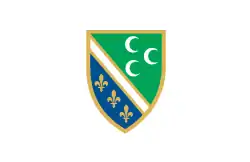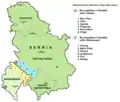إقليم السنجق
إقليم السنجق (بالصربية: Sandžak / Санџак) هو إقليم يقع في منطقة البلقان اقتسمته خلال الحرب الأهلية السابقة جمهورية صربيا والجبل الأسود من البوسنة والهرسك، تنقسم أراضي السنجق اليوم بين جهمورتي صربيا والجبل الأسود.[1][2][3]

علم إقليم السنجق
الديانة
الغالبية الساحقة من سكان السنجق هم من المسلمين البوشناق "البوسنيين" حيث يشكل المسلمون 87% وعدد سكان الإقليم 600 ألف نسمة وهنالك أيضاً المسيحيون الأرثوذكس والكاثوليك بنسبة ضئيلة من عدد سكان الإقليم.
معالم الإقليم

 الجدار الذي بني خلال الفترة العثمانية في نوفي بازار
الجدار الذي بني خلال الفترة العثمانية في نوفي بازار نوفي فاروش في حوالي عام 1930
نوفي فاروش في حوالي عام 1930 مسجد كوتشانسكا في روجايي, 1830
مسجد كوتشانسكا في روجايي, 1830 مركز نوفي فاروش في 2004
مركز نوفي فاروش في 2004 مسجد حسين باشا في بلييفليا
مسجد حسين باشا في بلييفليا دير ديورديفي ستوبوفي للروم الأرثوذكس قرب نوفي بازار
دير ديورديفي ستوبوفي للروم الأرثوذكس قرب نوفي بازار
التقسيم الاداري وأهم المدن
العاصمة نوفي بازار وأهم المدن الكبرى فيه هي توتين ذات الأغلبية المسلمة الخالصة تقرييباً حيث تبلغ النسبة فيها 94,47% وتليها مدينة روجايي بنسبة 88و74 ثم مدينة سيينيتسا بنسبة 75,69 % من عدد السكان.
 الموقع الجغرافي لإقليم السنجق في صربيا والجبل الأسود
الموقع الجغرافي لإقليم السنجق في صربيا والجبل الأسود خريطة لمنطقة راشكا/السنجق جنوبي صربيا والجبل الأسود في المدى الجغرافي الأكبر ووفقاً لبعض الآراء الأخرى، فإن البلديات المونتينيغرية من بلاف وأندرييفيتسا لا ينتمي بعضهما إلى جنوب السنجق
خريطة لمنطقة راشكا/السنجق جنوبي صربيا والجبل الأسود في المدى الجغرافي الأكبر ووفقاً لبعض الآراء الأخرى، فإن البلديات المونتينيغرية من بلاف وأندرييفيتسا لا ينتمي بعضهما إلى جنوب السنجق خريطة عرقية لإقليم السنجق (بما في ذلك بلاف وأندرييفيتسا) ووفقاً لتعداد عام 2011 في صربيا والجبل الأسود, ملاحظة: تظهر الخريطة السكان الأغلبية العرقية داخل البلديات
خريطة عرقية لإقليم السنجق (بما في ذلك بلاف وأندرييفيتسا) ووفقاً لتعداد عام 2011 في صربيا والجبل الأسود, ملاحظة: تظهر الخريطة السكان الأغلبية العرقية داخل البلديات
مراجع
- "Position of the Municipality of Priboj". مؤرشف من الأصل في 14 مارس 2019. الوسيط
|CitationClass=تم تجاهله (مساعدة) - "Territorial organisation of Republic of Serbia". مؤرشف من الأصل في 7 فبراير 2018. الوسيط
|CitationClass=تم تجاهله (مساعدة) - Cross-cultural ethnobiology in the Western Balkans: medical ethnobotany and ethnozoology among Albanians and Serbs in the Pešter Plateau, Sandžak, South-Western Serbia." Human Ecology. 39. (3): 335. "The current population of the Albanian villages is partly "bosniakicised", since in the last two generations a number of Albanian males began to intermarry with (Muslim) Bosniak women of Pešter. This is one of the reasons why locals in Ugao were declared to be "Bosniaks" in the last census of 2002, or, in Boroštica, to be simply "Muslims", and in both cases abandoning the previous ethnic label of "Albanians", which these villages used in the census conducted during "Yugoslavian" times. A number of our informants confirmed that the self-attribution "Albanian" was purposely abandoned in order to avoid problems following the Yugoslav Wars and associated violent incursions of Serbian para-military forces in the area. The oldest generation of the villagers however are still fluent in a dialect of Ghegh Albanian, which appears to have been neglected by European linguists thus far. Additionally, the presence of an Albanian minority in this area has never been brought to the attention of international stakeholders by either the former Yugoslav or the current Serbian authorities." "نسخة مؤرشفة". Archived from the original on 14 أغسطس 2017. اطلع عليه بتاريخ 26 ديسمبر 2017. الوسيط
|CitationClass=تم تجاهله (مساعدة)صيانة CS1: BOT: original-url status unknown (link)
وصلات خارجية
- News from Sandžak sandzaknews.net
- Novi Pazar
- Info about Sandžak
- Bosniak National Council in Serbia
- Community of the Sandžak diaspora
- Centre for Bosniak Study & Bošnjačka riječ magazine
- بوابة جغرافيا
- بوابة الإمبراطورية النمساوية المجرية
- بوابة التاريخ
- بوابة البوسنة والهرسك
- بوابة صربيا
- بوابة الجبل الأسود
في كومنز صور وملفات عن: إقليم السنجق
This article is issued from Wikipedia. The text is licensed under Creative Commons - Attribution - Sharealike. Additional terms may apply for the media files.
